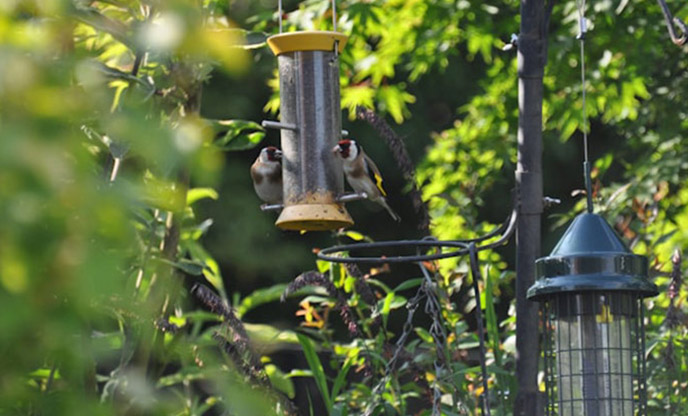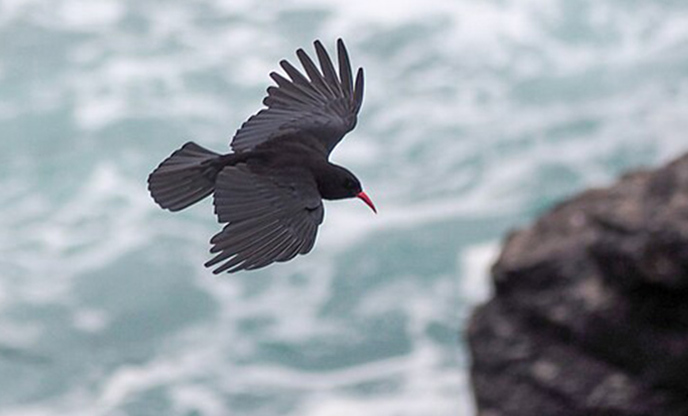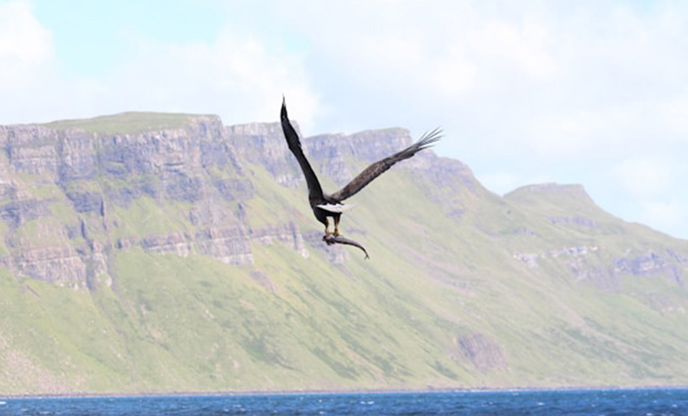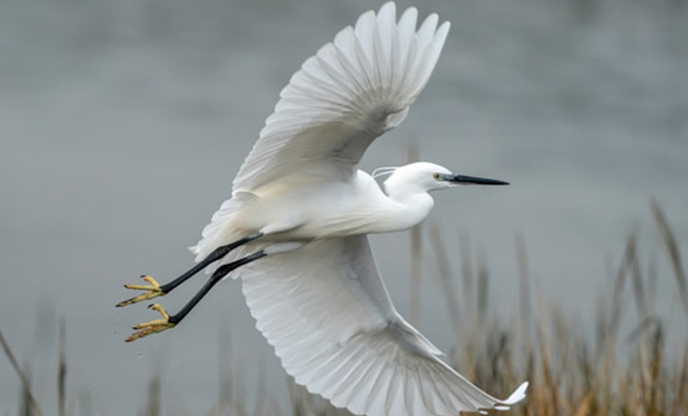A beginner’s guide to birdwatching in the UK
Penned on the 1st March 2024

Birdwatching is a simple yet enriching outdoor activity that can deepen our connections with nature and help boost our wellbeing – plus it can provide hours of free entertainment!
From tiny garden birds and long-legged waders to majestic birds of prey, there's such a great variety of feathered creatures here in the UK. Nature lovers of all ages will enjoy taking the time to observe them, identify them and understand more about their behaviours. And whether you’re out on a hike in the countryside or coast, or simply sitting in your back garden, the only equipment you’ll need is a pair of binoculars and a handy bird book or app.
We’ve put together this birdwatching guide for novice birders with top tips for getting started, as well as information about the types of birds you might see and some of our favourite locations to enjoy the activity across the UK.
Tips for getting started with birdwatching
Do some research before you leave the house

If you want to begin your birdwatching adventures with a little knowledge under your belt, start by researching the location and season you’re in to help you understand which birds are likely to be around and what behaviour they might be exhibiting (the RSPB website is a reliable source for this). Many birds in the UK are migratory so you could have a completely different experience with encounters in the spring and summer vs the autumn and winter.
Get some binoculars

Whilst you can go birdwatching without any equipment at all, having a pair of binoculars will make the experience all the more enjoyable. When it comes to birdwatching, the most powerful binoculars aren’t always the best because they’ll require a tripod to get a steady view. The most suitable for birdwatching will be something lightweight with 8x or 10x magnification – this will make it easier for you to quickly view a bird in flight.
Use a bird book or app

The best way to learn to identify different species in their natural habitats and discover interesting facts about them is to have a handy book or app that you can refer to when you’re out and about. A simple pocketbook like the RSPB’s Guide to British Birds would do the trick, or for something beautifully illustrated you might like to choose something like Britain’s Birds: A Treasury of Fact, Fiction and Folklore by Jo Woolf. Merlin Bird ID is an excellent free app that’ll help you to identify birds by their songs and chirps as well as their appearance.
Make a record of your sightings

Keeping a notebook about the birds you’ve noticed each time you go out will help you retain knowledge about the different species and their unique behaviours and habitats, as well as picking up on seasonal patterns. You could write about the bird’s location, the date and time, whether alone or with a flock, what it was doing and how it was interacting with its surroundings. You could even make this a creative practice and sketch your sightings. As an added benefit, journaling like this will help you to cultivate mindfulness, too.
Be a responsible birdwatcher

Some three million people go birdwatching every year in the UK – so RSPB has developed the Birdwatchers Code to keep the interests of the birds first. You can read about the code in full here but in a nutshell, the important things to remember are:
- Avoid getting too close to birds or disturbing their habitats. If a bird flies away or makes repeated alarm calls, you’re too close.
- Be an ambassador for birdwatching, helping others to foster a greater appreciation of wildlife.
- Know and follow the Countryside Code, sticking to public footpaths.
- Consider the interests of wildlife and local people before passing on news of a rare bird, especially during breeding season.
- Contribute to research and conversation by sending your sightings to the County Bird Recorder and the Birdtrack website.
Stay still

Birds are easily startled so staying still, quiet and patient will increase your chances of seeing them. In that sense, birdwatching provides the perfect opportunity for you to benefit from some truly peaceful time amongst nature too, enjoying your surroundings whilst you keep a lookout. Dawn is a particularly good time of day to do this – birds are often more active when there are fewer people around and less disturbances in general, so it’s worth setting your alarm and getting up a little earlier.
Make your garden more bird-friendly

What better way to increase your sightings than by attracting birds to your own garden? There are multiple ways you can do this including setting up bird tables and feeders, providing a birdbath for them to clean their feathers and drink from, or installing a nest box somewhere suitable and safe. There’s some helpful information on the best way to do all of this on the RSPB website here.
Birds that you might see in the UK
There are an incredible 634 species of birds of all shapes and sizes here in the UK, though only around 200 of them are common. Some reside here all year round and others are rarer migrants. Depending on the time of year and where you are, of course, you might spot any of the following (and more!):
Garden birds
Common species include sparrows, tits, finches, robins, blackbirds, starlings, wrens, dunnocks and other small birds in a beautiful spectrum of colours. You might spot them in your own back garden or local park.
Birds of prey
Buzzards, hawks, falcons, eagles, kites, harriers, osprey and owls are in this category of bird. They’re all hunters with acute vision and catch their food using powerful claws – and they make for majestic sightings.
Waterfowl
In our wetland habitats you can find a wonderful variety of ducks, geese and swans, especially in winter when large numbers migrate here from overseas.
Grebes and divers
Also found in wetlands, but in a category of their own, grebes and divers can hold their breath for great distances underwater – so you never know where they might surface!
Seabirds
Our coastlines are home to a diversity of seabirds, including gulls, terns, razorbills, gannets, shearwaters, shags, fulmars, and even puffins in some parts of the country.
Waders
Typically long-legged and long-billed, wading birds can often be seen on shorelines, river mouths and estuaries, looking for worms and molluscs in the mud.
Herons, egrets, spoonbills and cranes
Behaving similarly to waders, this category of bird is mostly tall with long pointy beaks, usually seen elegantly perched or hunting on the water’s edge.
Crows and shrikes
This characterful group includes crows, ravens, rooks, magpies, jays and jackdaws… choughs too, but with much smaller numbers they’re trickier to spot.
Grouse, partridge, pheasant and quail
Known as ‘gamebirds’, these birds have distinctive plump plumage. They’re ground-dwellers so you’ll usually find them in lowlands rather than in flight.
Pigeons and doves
There are five species of pigeon and dove in the UK – and not just the common ‘town pigeons’ you might see every day! Turtle doves and rock doves look similar to them but they’re actually extremely rare.
Woodpeckers
You might hear the distinctive sound of one of the UK’s three woodpecker species drumming against the trunk of a tree, but they’re not often easy to spot!
Swallows, swifts and martins
Often seen darting and diving in the sky in spring and summer, these small birds are fast flyers and spend almost all of their lifetime in the air.
Kingfisher
There’s just one type of kingfisher who resides in our country – but catching a glimpse of its dazzling azure and copper colour will make for an unmistakable identification.
You can find an A-Z list of all of the UK’s bird species on the British Trust for Ornithology website.
Some of our favourite birdwatching locations
Starling murmurations in Aberystwyth

One of the UK’s most incredible wildlife phenomena, starling murmurations usually take place at dusk in the autumn and winter months. You can see this mesmorising sight in multiple locations across the country but one of the best is at Aberystwyth in Cardigan Bay. Some 30,000 starlings swirl above the iron-latticed pier here, providing an absolutely breathtaking spectacle to anyone who’s lucky enough to witness it.
Stay nearby in this idyllic shepherd’s hut in the Ceredigion valleys.
Puffins on Skomer Island, Pembrokeshire

Situated less than a mile off the stunning Pembrokeshire coast in Wales, Skomer Island is world famous for its population of 42,000+ Atlantic puffins who reside here from mid-April to late July. But it’s not just the characterful puffins that draw birdwatchers to Skomer. The island is one of Britain’s most important seabird colonies, with 350,000 breeding pairs of Manx shearwaters, and thousands of guillemots, razorbills and kittiwakes. You can only get there by boat too, so it offers the perfect opportunity for a seabird-watching day out.
Take a look at our collection of beautiful hideaways in Pembrokeshire if you’d like to stay for a special escape.
Choughs in West Cornwall

The symbol of Cornwall, the chough was extinct for many years but has recently returned to the county in small but growing populations, much to the delight of birdwatchers. It stands out from other members of the crow family because of its bright red beak and legs contrasting its glossy black feathers, as well as its unique ‘chee-ow’ call. It can be seen in Scotland, Wales, Northern Island, the Isle of Man and the far west of Cornwall – although it’s still rare so you’re lucky if you catch a glimpse.
A walk along the Cornish coast path is a good place to start, and this coastal cabin on Cornwall’s rugged Lizard peninsula is the perfect base.
Birds of prey in Scotland

Scotland is home to many stunning birds of prey, including buzzards, kestrels, harriers and red kites – but one of its most spectacular has to be the golden eagle. This massive bird of prey has a wingspan of over two metres and hunts rabbits, foxes and even young deer. They’re a rare species but if you’re fortunate enough to see one, it’s likely to be soaring high amongst the peaks in upland areas in the north and west of Scotland.
Waders and waterfowl on the Exe Estuary, Devon

The broad Exe Estuary is one of the most important estuaries in Europe for wildlife and its wetland habitats are a haven for thousands of birds, especially waders and waterfowl. There are four RSPB reserves to explore here and you might spot redshank, dark-bellied Brent geese (migrated from Siberia), little egret, dunlin, oystercatchers, avocet, lapwing, curlew, grey heron and a great variety of ducks and gulls. You can even take a birdwatching cruise on the estuary if you fancy learning from the experts.
If you’re looking for somewhere to stay close by, take a look at this picture-perfect cottage set in an Area of Outstanding Natural Beauty a little further along the coast.
Ready to admire the UK’s wonderful species of birds? For an extra special escape explore our collection of magical hideaways nestled blissfully in nature.